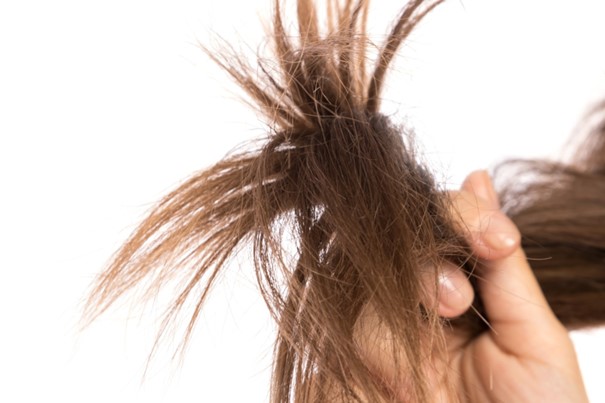Contents: Complete Damaged Hair Care and Repair Guide
This blog post may contain affiliate links. As an Amazon Associate I earn from qualifying purchases.
Damaged hair can be a real knock to your confidence. Frizzy ends, breakage, or a general lackluster appearance to your hair can ruin an otherwise great look. Our styling routines and our environment can take their toll on our hair. This is why it’s crucial to know techniques for remedying damaged hair, and even more important to know how to prevent it from occurring in the first place.
In this article, I’ll guide you through some essential tips for repairing damaged hair as well as telling you the steps I take to protect my hair from damage.
Understanding Hair Damage
By understanding how our hair becomes damaged, we can more effectively prevent it from occurring.
Strands of hair are composed of three layers; the cuticle (outer layer), the cortex (middle layer), and the medulla (inner layer). When we talk about “hair damage”, we are almost always talking about damage to the cuticle. This causes the hair to lose moisture and shine.
Types of Hair Damage
There are four main causes of hair damage;
1. Mechanical Damage
This damage is caused by roughly handling your hair, tying it too tightly, or brushing it too aggressively.
2. Chemical Damage
Coloring, perming, or over-shampooing your hair can cause chemical damage, which alters the structure of your hair.
3. Heat Damage
Blow drying, curling, and straightening can all cause heat damage to your hair.
4. Environmental Damage
Sunlight, humidity, air conditioning, and pollution can all affect the texture of your hair.
Signs of Damaged Hair
Knowing what to look for is important. The earlier you notice that your hair is damaged, the sooner you can do something about it.
1. Split Ends
Split ends, or trichoptilosis, happens when your hair’s cuticle wears away. This causes the hair fiber to split into multiple fragments.
2. Dullness
Flat and lifeless hair lacks a natural shine and bounce. This is often caused by a buildup of too much product. This can weigh your hair down and make it reflect less light, so it loses its perceived shine.
3. Frizz
Frizz is when you have strands of hair which curl or stand up. Too many of these make your hair look unruly. This happens because the cuticles are raised, allowing moisture to enter the hair shaft.
4. Dryness
When your hair lacks sufficient moisture, it is more prone to breakage and has a less pleasant texture and appearance. Sun exposure, air conditioning, heat styling, and too much product stripping your hair of its natural oils can all cause dryness.
5. Breakage
When your hair breaks along the hair strand (not just the ends) it can leave you with hairs at different random lengths and lead to you having uneven and messy looking hair.
Any of these types of damage is a sign that you need to change something in your environment or hair care routine to repair the damage. But before we look at treatments, let’s look at how you can prevent this damage occurring in the first place.
How To Prevent Hair Damage
Adopting the following practices can help prevent the majority of hair damage. Try incorporating some of these into your hair care routine. It is much easier and cheaper to prevent hair damage than to reverse it.
Gentle Brushing/Combing
- Use a wide tooth comb.
This will help prevent breakage. - Avoid excessive brushing.
Rather than brushing by default, only brush your hair when it needs it. Take it slow and don’t rush, this way you are less likely to damage your hair. - Don’t comb or brush your hair while it is wet.
Combing your hair when it is wet is much more likely to split.
Proper Washing Techniques
- Use Lukewarm Water
Hot water can strip your hair of its natural oils, so try reducing the temperature of your showers to prevent heat damage. - Choose Sulfate-Free Products
Products can strip your hair’s oils and also leave a buildup of residue. Use a sulfate-free alternative. They are a little more expensive but definitely worth it. - Avoid Over-Washing
Washign your hair too much can lead to dry and dull hair. If you are washing your hair every day, try switching to washing it every other day, or even every three days and see if it improves. You should see a difference fairly quickly.
Avoiding Heat Damage
- Use Heat Protectant Sprays
Using a spray which creates a barrier against heat damage is essential if you live in a warm climate. - Limit Heat Styling
Try to reduce how often you use heat styling tools like tongs or curling irons. I only use these when I’m going out to an event, I no longer use heat styling as part of my daily hair care routine. - Lower Tool Temperatures
When you do use heat styling tool, or even when you use a hairdryer, try lowering the temperature. - Less Frequent Coloring
Too much coloring and bleaching can do serious damage to your hair. When I was a teenager, I would be dying my hair multiple colors a month and over time my hair became thinner and dryer. Space out your chemical treatments to prevent damage and product buildup. - Professional Services
While it is a little more expensive, you are much less likely to damage your hair by using a professional for any heavy chemical treatments. These days I go to the salon for pretty much anything beyond basic dying.
Repairing Damaged Hair
While prevention is better than cure, if your hair is already damaged, don’t worry – there are ways you can help it to recover, repair and rejuvenate.
- Deep Conditioning Treatments
A deep conditioner or a hair mask can really work wonders. Use one once a week and leave it in as long as possible to help your hair lock in moisture. - Protein Treatments
Protein is key to your hair’s strength. It helps to replace the keratin. However, too much protein can actually make your hair brittle, so be sure to follow the instructions on your particular protein treatment and don’t overdo it. - DIY Hair Masks and Treatments
One of my favorite DIY hair tips is to mix a tablespoon of honey with a mashed avocado. Apply it as a mask for your hair and leave it in for 30 minutes before rinsing it out thoroughly. This is a natural way to nourish and soften your hair, and it smells great too! - Leave-In Conditioners and Serums
Leave-in conditioners help lock-in moisture and keep your hair hydrated. I always look for ones which have ingredients like argan oil, coconut oil, and shea butter. - Trimming and Cutting
Regualr trims are the only way to remove split ends. If your hair is severely damaged by years of heat and chemicals, consider going for a short hairstyle and then starting fresh with a new, gentler haircare routine as it grows back. - Balanced Diet and Hydration
You hair is reflective of your overall health. Make sure you are eating well, have enough protein in your diet, and are getting enough sleep. - Protective Hairstyles
Low-manipulation hairstyles, like braids and buns, will help prevent damage from overhandling.
Professional Help and Treatments
Sometimes, home haircare isn’t enough. It’s important to know when it’s time for professional help.
If your hair is showing signs of serious damage and home treatments are not making any difference, it’s time to book a treatment at a salon. Don’t treat this as a bad thing though, make a day of it treat yourself. Salon keratin treatments like Olaplex can repair and strengthen your hair.
If your scalp is itchy, dry, or flaking, you may need to see a dermatologist. They can provide proper medical treatments which are not available over the counter.
Take Care Of Your Hair!
Caring for your hair is a lifelong process. There are no miracle cures. But over time, making small changes to your routine like not combing your hair while wet, or using a weekly leave in treatment, will show big results.
I hope this has been a useful guide to the different kinds of hair damage, how to prevent them, and how to help your hair recover.


